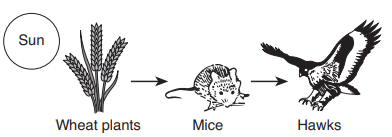SilverZone - ITHO PDF Sample Papers for Class 4
Q.1 |
What do we call the process in which the water changes to water vapour? |
| a) |
Sublimation |
| b) | Condensation |
| c) | Evaporation |
| d) | Melting |
Q.2 |
The diagram below shows a food chain:  |
| a) |
decrease |
| b) | increase |
| c) | remain the same |
| d) | Cannot say |
Q.3 |
Onion shows the modification of which part for food storage? |
| a) |
Flower |
| b) | Stem |
| c) | Root |
| d) | Fruit |
Q.4 |
Ravi pushed a heavy table but failed to move it. Which of the following is TRUE about the above statement? |
| a) |
Energy is not spent but work is done |
| b) | Energy is spent but work is not done |
| c) | Energy is not spent and work is not done |
| d) | Energy is spent and work is done |
Q.5 |
Which of the following has a fibrous root? |
| a) |
Radish |
| b) | Carrot |
| c) | Beet root |
| d) | Wheat |
Q.6 |
Rajeev wants to buy a shirt made up of a natural fibre. Which of the following option is the best choice for it? |
| a) | Polyester |
| b) | Rayon |
| c) | Nylon |
| d) | Cotton |
Q.7 |
Complete the following statements and choose the correct option:
|
| a) |
Statement 1 is correct but statement 2 is incorrect |
| b) | Statement 1 is incorrect but statement 2 is correct |
| c) | Both the statements are correct |
| d) | Both the statements are incorrect |
Q.8 |
Choose the food materials that are required for growing children of your age. Fats, Rice, Wheat, Cheese, Pulses, Chocolate, Beans |
| a) |
Fats, Wheat, Chocolate |
| b) | Rice, Cheese, Pulses |
| c) | Chocolate, Beans |
| d) | Cheese, Pulse, Chocolate |
Q.9 |
Consider the following statements and choose the correct option: 1. Premolars are used for tearing food. 2. Vitamin C prevent the disease of bleeding gums or scurvy. |
| a) |
Only 1 is correct |
| b) | Only 2 is correct |
| c) | Both 1 and 2 are correct |
| d) | Both 1 and 2 are incorrect |
Q.10 |
We can obtain drinking water from the sea by the process of _____. |
| a) |
desalination |
| b) | condensation |
| c) | sublimation |
| d) | freezing |
Your Score: 0/10

Sample PDF of SilverZone - International Talent Hunt Olympiad (ITHO) PDF Sample Papers for Class 4:
If your web browser doesn't have a PDF Plugin, you can Click here to download the PDF
Answers to Sample Questions from Olympiad Success:
Q.1 : c | Q.2 : a | Q.3 : b | Q.4 : b | Q.5 : d | Q.6 : d | Q.7 : d | Q.8 : b | Q.9 : b | Q.10 : a
Other Classes Sample Papers
- International Talent Hunt Olympiad (ITHO) PDF Sample Papers for Class 1
- International Talent Hunt Olympiad (ITHO) PDF Sample Papers for Class 2
- International Talent Hunt Olympiad (ITHO) PDF Sample Papers for Class 3
- International Talent Hunt Olympiad (ITHO) PDF Sample Papers for Class 5
- International Talent Hunt Olympiad (ITHO) PDF Sample Papers for Class 6
- International Talent Hunt Olympiad (ITHO) PDF Sample Papers for Class 7
- International Talent Hunt Olympiad (ITHO) PDF Sample Papers for Class 8
- International Talent Hunt Olympiad (ITHO) PDF Sample Papers for Class 9
- International Talent Hunt Olympiad (ITHO) PDF Sample Papers for Class 10
Other Subjects Sample Papers
- International Informatics Olympiad (IIO) PDF Sample Papers for Class 4
- International Olympiad of Mathematics (IOM) PDF Sample Papers for Class 4
- International Olympiad of Science (IOS) PDF Sample Papers for Class 4
- International Olympiad of English Language (IOEL) PDF Sample Papers for Class 4
- Smart Kid General Knowledge Olympiad (SKGKO) PDF Sample Papers for Class 4



